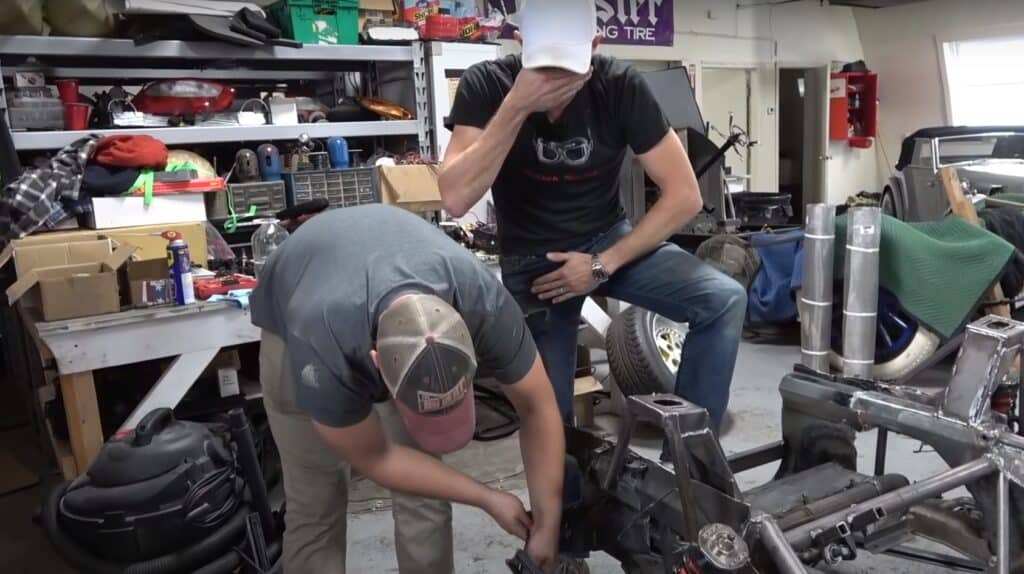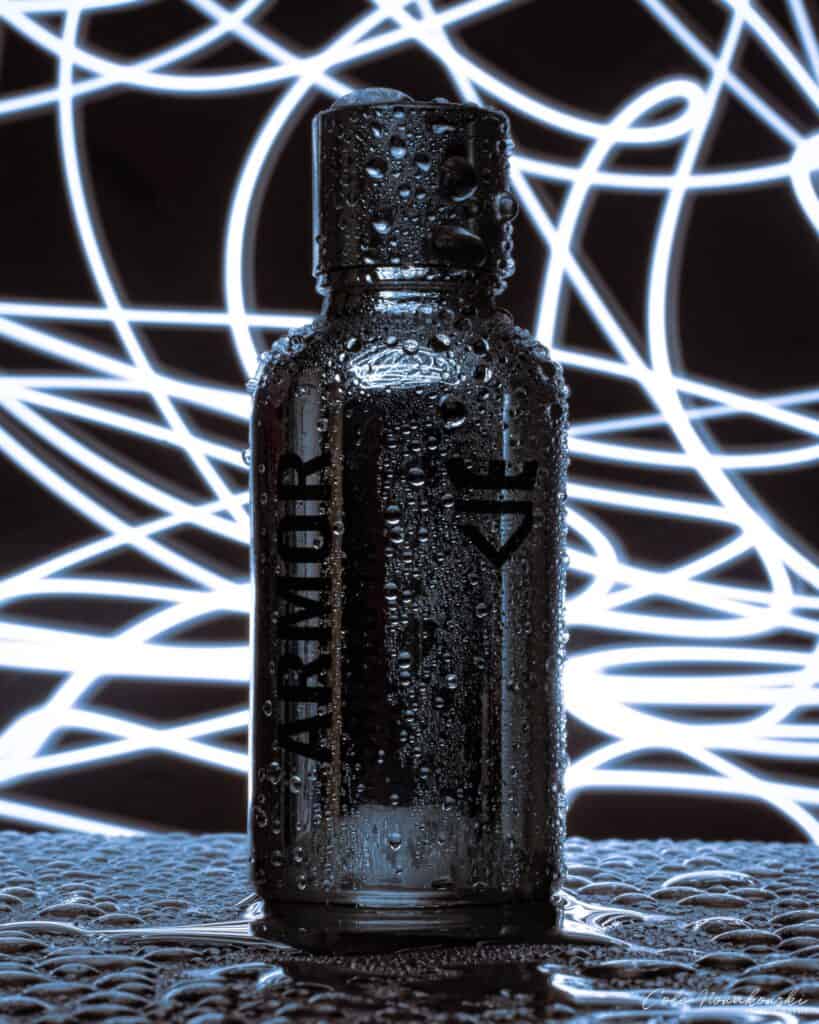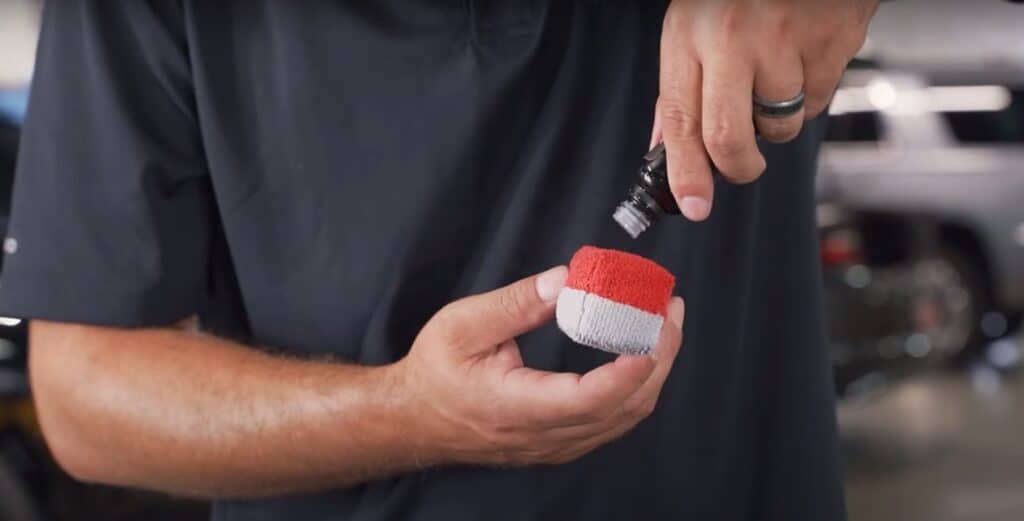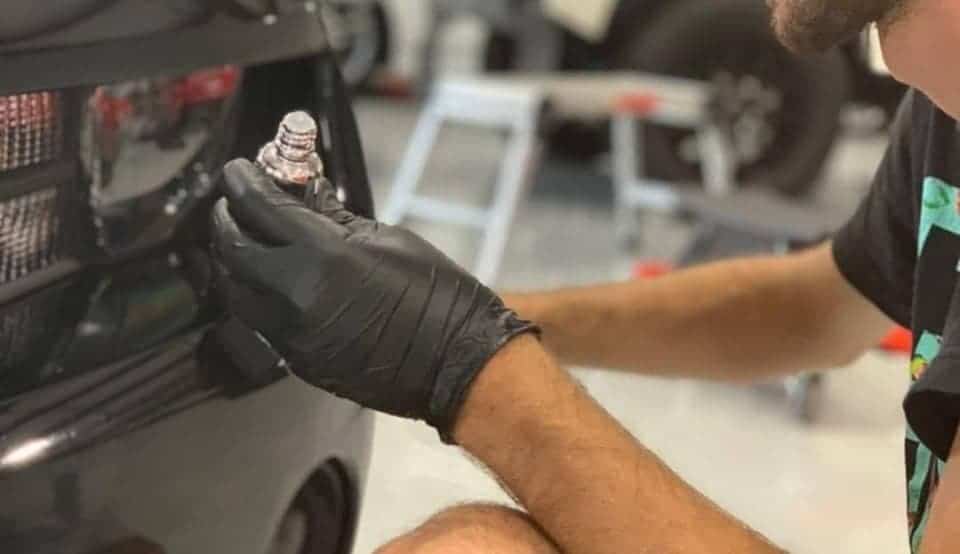Applying ceramic coating to hard surfaces is kind of like getting tattoo work from an artist you admire, or diving head-first into a heaping basket of chips and salsa down at the local cantina. Once you start, it’s damn near impossible to stop. DIY devotees are bordering being labeled as “addicts” too, as they coat everything from exposed metal armor on off-road vehicles, to the clear coat sitting atop their supercar’s paintwork, and that’s just the tip of the corn chip…
We’ve seen people coat their glass and mirrors, rain visors and hood deflectors, headlamps, plastic trim, bumpers, wheels, exhaust tips, grille, and backup cameras. When word got out that any hard surface was fair game, DIY enthusiasts really put ceramic coatings like Armor Shield IX to the test, and to great success.
So what about our bodies? Does a ceramic coating pose any health risks if it comes into contact with exposed skin? What about inhalation risks, or the dangers these chemical compounds may pose to someone’s vision? Over the years these, and many more safety concerns have emerged, both out of fear of the unknown, and from a general lack of knowledge.
So let’s set aside all of the assumptions and second-guessing for a moment, so that we can get down to the facts. There’s already enough misinformation out there on the interweb, so we might as well set the record straight.
Common Concerns Over Ceramic Coating Health Risks

The Environment
Let’s begin with a few environmental precautions, because we’re all on this miserable little rock together, and it’s already fucked-up enough as it is. While keeping chemical-filled products from contaminating sewer systems, surface water, and soil should be a no-brainer, it behooves us to reinstate the fact that Armor Shield IX is not meant for toilet bowl protection, swimming pool reinforcement, or gardening purposes.
However, if for some reason you do happen to drop your brand new bottle of ceramic coating, the suggested methods and materials for containment and cleaning are as follows:
Soak everything up immediately with an absorbent material. Dry sand, vermiculite, or even a microfiber cloth all do a stellar job of absorbing a silicon dioxide-based ceramic coating when it’s still in its liquid state. Once completely absorbed, safely dispose of the media used during clean-up in accordance with local disposal regulations, and then reinspect the area where the accident occurred. If dropped on a hard surface, spray the area in question with a strong isopropyl alcohol blend or a pH-rich soap to lift any stubborn residue.
Storage
As for storage precautions, an unopened bottle of Armor Shield IX can sit on the shelf for up to 5 years before it begins to lose its “zip.” Granted, this shelf life relies heavily upon the need for an environment where 18° Celsius (64.4° Fahrenheit) temperatures are observed year-round, as sudden spikes in heat and cold can compromise the product’s chemical structure. So if you plan on sticking that bottle of ceramic coating on the shelf until spring, make sure that it is packed into a tightly closed container that can be positioned in a dry, cool, well-ventilated area.
Fire
While it is incredibly rare, there may be an occasion when some inconsiderate or clumsy individual will set your unopened box of ceramic coating on fire. While the coating itself is extremely hard to ignite (Armor Shield IX has a sustained heat tolerance rating of 440° Fahrenheit), the box itself, and all of the other contents contained therein are susceptible to fire. So if that cardboard catches fire, and the microfiber cloths within light the application pad, thus forcing the bottle of DIY ceramic coating to ignite, the following fire fighting measures should be implemented immediately.
Grab one of the following forms of fire extinguishing media, and hit that blaze with all you’ve got. Your options include: Carbon dioxide, a dry chemical flame suppression powder, or an extinguishing foam. Just be wary of the fumes being emitted from this incendiary catastrophe, which as you shall soon discover, may pose some serious health threats.
Fume Inhalation

While we’re on the topic of breathing chemicals, let’s turn toward the topic of the fumes ceramic coatings emit, and what they do to our bodies.
While it is always advisable to wear a ventilation mask when applying a ceramic coating, many people opt to forego this DIY safety equipment, and here’s why. Armor Shield IX has been classified as a product with a very “faint scent,” with many installers finding this aroma to be far from offensive.
However, there are cases where DIY installers have found that their bodies react negatively to the scent of ceramic coatings. the following customer feedback offers a glimpse of what some people experience when they install a ceramic coating in an enclosed space.
“I felt that the odors/fumes from the product were a bit strong for applying indoors, so I had to grab my ventilation mask and leave the area while the product dried. I did crack the garage doors a little bit, but I was limited by wind and rain outside from fully opening the doors (a downside to applying the product in the winter time). I would recommend that people grab a mask if applying indoors with limited air circulation like in a garage.”
-Anonymous Armor Shield IX Customer
This feedback is why, for respiratory protective purposes, we strongly recommend applying Armor Shield IX in well-ventilated areas. While taking the application process outdoors should be avoided for obvious reasons, a draw fan that funnels fumes out of a garage or work space, or even something like a screened door or window will do wonders for your lungs.
Just beware, for as we alluded to earlier, unique inhalation hazards arise when this substance ignites, and the risks associated with breathing smoke filled with silicon oxide fumes can be significant.
Quick Tip: While not mandatory, many people opt to wear safety glasses, or goggles with side shields when installing a ceramic coating. Although splashing or spraying hazards are extremely low, the peace of mind associated with eye protection far outweighs the unpleasant sensation of rushing off to an eyewash station.
Let’s Talk Armor Shield IX Contents

The composition of the components found within every bottle of Armor Shield IX include enhanced polymer silicon components (nano Sio2), nano titanium dioxide (nano TiO2), activated fluorine, brightened silicon particles, polysilazane, sodium hydroxide (NaOH), triethanolamine, water, and trace amounts of essential other media.
Years of lab research and testing have revealed time and time again that these components will not harm the hard surfaces found on an automobile, boat, plane, ferris wheel, pogo stick, home bakery, or tackle box. Alright, so maybe we have yet to test an Armor Shield IX ceramic coating kit on some of these things, but you get the general idea.
Quick Nerd Note: Ceramic coatings rely heavily upon a naturally occurring substance called “silicon,” which is derived from silica, or sand. You can find silicon labeled on the periodic table as the 14th element, and being that it is a metalloid, it has the ability to retain both metal and nonmetal properties. Silicon is currently revered as the second most common element buried beneath our planet’s surface, as only oxygen is more abundant.
Ceramic Coating and Skin Contact

When properly applied, and then allowed to fully cure, Armor Shield IX has the ability to become a scratch-resisting, dust preventing, water-repelling, paint protecting, crystal-clear, glossy coating of unrivaled awesomeness. But what does this stuff do to your skin when it is permitted to soak-in for a hot minute?
While Armor Shield IX has been proven to be safe to use on most hard surfaces, it does create some rather unpleasant reactions when exposed to human skin. So if you happen to spill some ceramic coating on your body, stop what you are doing, and immediately scrub the exposed area with a high pH soap and plenty of water.
Quick Tip: While the chemical resistance level of Armor Shield IX is rated as “excellent,” it is vulnerable to liquids with high pH ratings, so use a strong soap like Jergens, Irish Spring, Dial, Ivory, Zest, or Nivea for the fastest results.
After speaking with our in-house product specialist, Dale, about the topic of substituting Armor Shield IX for a topical ointment or skin lotion, he had the following to say…
“So the stuff
-Dalewill really dry out your hands. So definitely avoid skin contact and remember that those gloves are there for a reason.”
While hand protection should definitely be labeled as mandatory when installing a ceramic coating, there are some other safety products that should be put into play to keep you and your skin safe. The use of clothing like coveralls or an apron, along with boots (forgo the flip-flops folks), or a lab coat for all of you mad scientists out there, are all a great way to keep your epidermis protected.
All told, mild skin irritation and dryness have remained the only noted side effects of our ceramic coat during lab testing. While more sensitive areas like eyelids, nasal cavities, or genitalia were not exposed to our ceramic coating during testing, we really didn’t feel like the product needed to be tested in such a fashion. So don’t use Armor Shield IX to remove wrinkles around your eyes, as a vapor inhaler, or a form of protection on your naughty bits, and you should be fine.
Ceramic Coatings and the CDC

According to the United States Center of Disease Control (CDC), the key ingredient found within bottles of Armor Shield IX, bears little to no risk to the human body. Symptoms of irritation have been labeled as those of the eyes, skin, and upper respiratory system, which typically results in the development of a cough, and only after extended exposure.
While titanium dioxide (TiO2) has been linked to things like lung fibrosis (a potential occupational carcinogen), that’s only when someone is exposed to concentrated amounts in an atmosphere for prolonged periods of time. Most ceramic coatings typically contain miniscule amounts of titanium dioxide, which remains suspended in liquid form while within the bottle.
The same goes for sodium hydroxide (NaOH), which by definition is “an odorless, white crystalline solid that absorbs moisture from the air.” While concentrated amounts can be very corrosive, causing damage to eyes, skin, mucous membrane, and forcing temporary hair loss, the level of harm “depends upon the dose and duration.” So no need to sweat folks. You would need to be directly exposed to a large amount of sodium hydroxide before you saw any health issues, and ceramic coatings don’t pack nearly enough of this stuff to warrant concern.
Quick Nerd Note: Sodium hydroxide is prevalent in many areas of daily human life. From soaps and rayon, to paper, explosives, dyes, and petroleum products, this chemical makes it all possible. You can even find sodium hydroxide in cotton fabric, laundering and bleaching chemicals, metal cleaning and processing phases, oxide coatings, electroplating, and even electrolytic extracting. Due to its corrosive nature, it is also commonly found in drain and oven cleaners.
When in Doubt, Turn to the Experts

As we continue our nerdy glimpse into the molecular makeup of ceramic coatings, we encounter America’s National Library of Medicine, which explains that triethanolamine is only labeled as harmful when swallowed, and in concentrated form, can be an eye and skin irritant. So what does this mean for you, the ceramic coating user? Don’t use Armor Shield IX as a moisturizer or eye drop, and don’t gargle with it after brushing.
Joking aside, we find it curious that triethanolamine remains a popular pH balancer. This chemical continues to find a home as a primary ingredient within many cosmetic and grooming products, such as skin lotion, eye gels, moisturizers, shampoos, and shaving foams.
Moving on to some of the final pieces of the ceramic coating puzzle, the need to turn to The American Coatings Association for an explanation of polysilazanes, which offers far more benefits than risks. Apparently, this pre-ceramic polymer packs a silicon-nitrogen backbone, which in recent years, has caused it to become one of the world’s most popular binders.
Redeveloped as a high-performance binder, this chemical has experienced high demand due to its ability to offer protective properties for transportation vehicles, commercial and residential buildings, and even industrial plants. Why? Polysilazanes are temperature resistant, hard as all hell, offer weather and corrosion protection, and have been known to reject attempted graffiti applications via various forms of media. Sound familiar? It should. These protective properties, and many more, are what have earned Armor Shield IX the highest 9H-rated ceramic coating rating on the planet.
Parting Shots

So there you have it. Armor Shield IX does not pose any major threats to human safety, as long as you do not apply it directly to your skin, or attempt to use it as a mouthwash or contact solution.
That said, erring on the side of caution, and applying a ceramic coating in a well-ventilated area, while wearing a mask is always the best (and safest) approach. Hell, by this point we’ve all become fairly accustomed to wearing a mask, so you might as well play it safe, and rock one during that coating install to negate any respiratory concerns.












